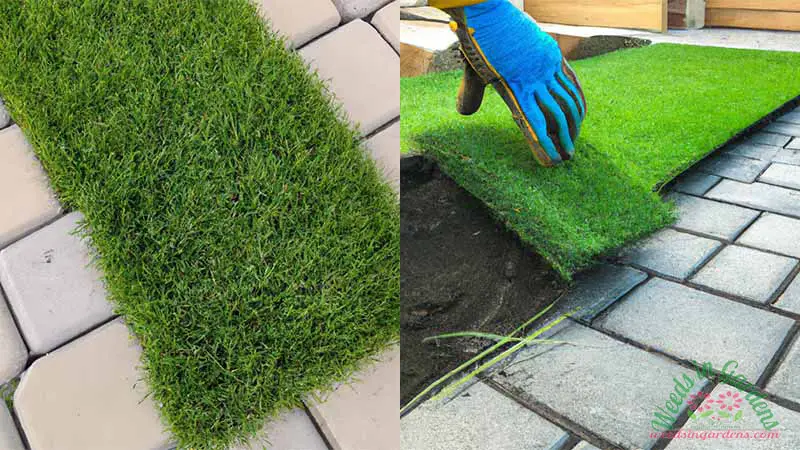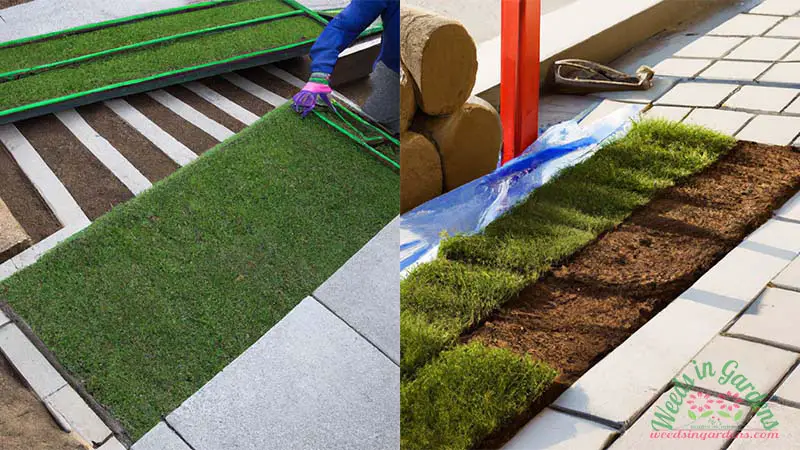Artificial grass is becoming more popular as a low-maintenance and aesthetically pleasing alternative to real grass. It’s becoming more common to see it being used for residential and commercial landscaping projects, and one particular application that has been gaining traction is installing artificial grass between pavers.
This blog post will talk about the benefits of using fake grass between pavers, how to put it down, and how to keep it looking good. We’ll also discuss some potential drawbacks and answer common questions about this application. Whether you’re a homeowner, landscaper, or commercial property manager, this article should help you learn more about this popular landscaping technique.

The Advantages of Artificial Grass Between Pavers
Aesthetic appeal, durability, and low maintenance are just a few of the advantages of using artificial grass between pavers.
Aesthetic appeal:
One of the primary benefits of using artificial grass between pavers is its added visual appeal to a patio, walkway, or other outdoor areas. Artificial grass provides a lush, green look that is perfect for adding contrast and texture to a hardscape design. It can also be a great way to incorporate more greenery into your outdoor space without the maintenance requirements of natural grass.
Durability:
Another advantage of artificial grass is its durability. It is made from synthetic materials that are designed to withstand heavy foot traffic and resist wear and tear over time. This makes it an excellent option for high-traffic areas that might otherwise require frequent maintenance or replacement.
Low maintenance:
Maintaining natural grass can be time-consuming and costly, requiring regular mowing, watering, fertilizing, and weeding. Artificial grass, on the other hand, requires very little maintenance. Once installed, it only needs occasional cleaning and brushing to keep it looking fresh and new.
In addition to these benefits, artificial grass is also non-allergenic, non-toxic, and free of common allergens such as pollen and grass clippings. This makes it a great option for those with allergies or sensitivities to natural grass.
Artificial grass between pavers is a great solution for creating a visually appealing, low-maintenance outdoor space that can withstand heavy use and last for years to come.
How to Install Artificial Grass Between Pavers

If you’re considering installing artificial grass between pavers in your outdoor space, here are the steps you’ll need to follow:
- Preparation:
The first step in the installation process is to determine the amount of artificial grass you’ll need and gather the necessary tools and materials. You’ll need to measure the area where you want to install the grass and purchase enough artificial turf to cover the space.
- Excavation:
The next step is to remove any existing grass or soil from the area where you’ll be installing the artificial grass. This can be done using a shovel or other excavation tools. It’s important to remove any rocks, debris, or other obstacles that could damage the artificial grass or create an uneven surface.
- Base preparation:
Once the area is cleared, you’ll need to prepare a stable base for the artificial grass to rest on. This typically involves adding a layer of crushed stone or gravel to create a stable surface for the artificial grass. The depth of this layer will depend on the specific application and the type of soil and drainage in the area.
- Cutting and laying the grass:
Next, you’ll need to measure and cut the artificial grass to fit the designated area. It’s important to ensure that the grass is cut precisely to fit between the pavers and covers the entire area. Once the grass is cut, it can be placed between the pavers.
- Securing the grass:
There are a few ways to secure the artificial grass in place. One option is to use adhesive to attach the grass to the pavers. Another option is to install edging around the perimeter of the area to hold the artificial grass in place.
- Finishing touches:
Finally, you’ll need to add infill to the artificial grass to help it stand up and create a natural look. Infill can be made from a variety of materials, including sand, rubber, or a combination of both. Once the infill is added, the artificial grass should be brushed to help it stand up and create a natural look.
By following these steps, you can install artificial grass between pavers and create a low-maintenance, visually appealing outdoor space that can withstand heavy use and last for years to come.
Tips for Maintaining Artificial Grass Between Pavers
While artificial grass between pavers requires very little maintenance compared to natural grass, there are a few things you can do to keep it looking its best:
- Brushing:
Regular brushing of the artificial grass can help keep the blades standing upright and looking natural. This is especially important in high-traffic areas where the grass may become flattened.
- Cleaning:
Occasional cleaning of the artificial grass can help remove debris, dirt, and other particles that may accumulate on the surface over time. This can be done using a leaf blower, broom, or hose.
- Removing Stains:
If a stain does occur on the artificial grass, it’s important to act quickly to remove it. Most stains can be removed using a mixture of water and mild detergent. Tougher stains may require a more specialized cleaner.
- Inspecting for Damage:
Periodically inspect the artificial grass for any signs of damage, such as tears or rips. If any damage is found, it’s important to repair it as soon as possible to prevent it from becoming worse.
- Avoid Heavy Equipment:
Avoid driving heavy equipment or machinery over the artificial grass, as this can damage the blades and backing.
- Be Mindful of Pets:
While artificial grass is great for pet owners because it requires minimal maintenance, it’s important to be mindful of pets using the space. Regularly pick up solid waste and rinse the area with a hose to prevent odors from developing.
By following these tips, you can help ensure that your artificial grass between pavers stays looking great and lasts for years to come.
Potential Drawbacks of Artificial Grass Between Pavers
While artificial grass between pavers offers many benefits, there are also a few potential drawbacks to consider before making a decision:
- Cost:
Artificial grass can be more expensive than natural grass or other ground covers, which can be a barrier for some homeowners. However, it’s important to consider the long-term cost savings that come with low maintenance and durability of artificial grass.
- Heat Retention:
Artificial grass can retain more heat than natural grass, which can make it uncomfortable to walk on during hot summer days. However, there are ways to mitigate this issue, such as using a lighter colored turf or adding shade structures to the area.
- Drainage:
While artificial grass is designed to drain water quickly, improper installation can result in water pooling on the surface. This can be especially problematic in areas with heavy rainfall or poor drainage.
- Appearance:
While artificial grass has come a long way in terms of appearance, some people may still prefer the look and feel of natural grass. It’s important to consider the aesthetics of the space and how the artificial grass will fit in with the surrounding environment.
- Environmental Concerns:
While artificial grass is often touted as an environmentally friendly alternative to natural grass, some experts have raised concerns about the materials used to produce and dispose of artificial turf. It’s important to research the environmental impact of the specific product you are considering before making a decision.
Overall, the potential drawbacks of artificial grass between pavers are outweighed by the benefits for many homeowners. It’s important to carefully consider the specific needs of your outdoor space and weigh the pros and cons of artificial grass before making a decision.
Frequently Asked Questions about Artificial Grass Between Pavers
- Is artificial grass between pavers difficult to install?
Installing artificial grass between pavers is relatively straightforward and can be done by a DIY homeowner with basic tools and some landscaping knowledge. However, hiring a professional is recommended for larger projects to ensure a proper installation.
- How long will artificial grass between pavers last?
The lifespan of artificial grass can vary depending on the quality of the product, the amount of foot traffic it receives, and how well it is maintained. High-quality artificial grass can last up to 15 years or more with proper care and maintenance.
- Can pets damage artificial grass between pavers?
Artificial grass is a great option for pet owners because it is durable and easy to clean. However, pets can still damage the grass by digging or scratching at it. It’s important to train your pets to use the designated area and keep an eye on them when they are playing on the grass.
- Can I use artificial grass between pavers in areas with heavy rainfall?
Yes, artificial grass is designed to drain water quickly and can be used in areas with heavy rainfall or poor drainage. Proper installation and base preparation are important to ensure proper drainage.
- How much maintenance does artificial grass between pavers require?
Artificial grass between pavers requires very little maintenance compared to natural grass. Regular brushing and occasional cleaning are typically all that is needed to keep the grass looking its best.
- Is artificial grass between pavers safe for children to play on?
Yes, artificial grass is safe for children to play on. Most artificial grass products are designed to be non-toxic and free from harmful chemicals. Choosing a high-quality product from a reputable manufacturer is important to ensure safety.
- Can I install artificial grass between pavers myself, or do I need to hire a professional?
A DIY homeowner can install artificial grass between pavers with basic tools and some knowledge of landscaping. However, hiring a professional for larger projects or those with no landscaping experience is recommended to ensure a proper installation.
By addressing common questions and concerns about artificial grass between pavers, homeowners can decide whether this low-maintenance, durable ground cover is right for their outdoor space.
Conclusion
Artificial grass between pavers is a low-maintenance, durable ground cover option that offers many benefits to homeowners. It is a great choice for those who want to enjoy a lush green lawn without the hassle of mowing, watering, and fertilizing natural grass. With proper installation and maintenance, artificial grass can last for many years and provide a beautiful and functional outdoor space.
While there are a few potential drawbacks to consider, such as cost and heat retention, the benefits of artificial grass between pavers outweigh the cons for many homeowners. By carefully considering the specific needs of their outdoor space and weighing the pros and cons, homeowners can make an informed decision about whether artificial grass between pavers is the right choice for them.
Whether you’re looking to create a beautiful outdoor living space, a safe play area for kids and pets, or simply a low-maintenance yard, artificial grass between pavers is definitely worth considering. With its long-lasting durability, low maintenance requirements, and versatile applications, it’s a smart investment for any homeowner looking to enhance the beauty and functionality of their outdoor space.
